It really feels like quite a long time since we left home, but in reality we have only been away for 6 weeks, the past two all in the same location!
Rain has prevented us from continuing northward, but we have seen hardly a drop.
I’ll come back to that , but first a catch up as to where we have been prior to arriving here in the remotest town in New South Wales, Tibooburra in the ‘Corner Country’ of the far west of the state. Outback. Close to the meeting of the borders of 3 states, NSW, Queensland & South Australia.

Our last post saw us experiencing South Australia, the country’s driest state, at it’s driest. In drought with it’s southern farming land looking like desert & a number of towns very worried about their water supplies. It was dry & dusty, not especially pleasant when the hot winds got up. We did however find a very pleasant oasis in the ocean-side suburbia of the Fleurieu Peninsula. Not suburbia as in city-like suburbia, more country style beach suburbia. We visited online friends Lee & Ann (& Elwood their dog whom of course we loved fussing over) at Goolwa Beach, where they have relocated to in fairly recent times – a ‘sea change’ from previous city life. A move both of them have embraced & clearly love. For us it meant a sheltered & quiet location with the warmth & hospitality of friends we were meeting ‘in the flesh’ for the first time. Although we only stopped by for a day & a night, we were made very welcome & their passion for the lifestyle they have adopted shone through. We were treated to a tour of the area, learning a lot about the lakes, islands & mouth of the Murray River. A part of the country we have never previously visited. Of course there is far more in the area that we didn’t see. The Fleurieu Peninsula is an area we think we will return to in the future, probably when we eventually give up full time travel. It will be close enough to home to access on a shorter trip. Sadly our time there has no photographic record. The camera didn’t get unpacked & I only realised I had left my phone behind after we had set off on the tour of the area which were treated to. The highlights for us were a visit both to the mouth of the Murray, an iconic Australian spot where the continent’s longest river meets the ocean, and the series of ‘barrages’ we had never previously been aware of. The concrete & steel structures, built in the 1930’s, an impressive engineering feat, stretch between islands with a construction distance of almost 8 kilometres, & serve to separate salt & fresh water, the fresh water being a major supply for South Australia. Best (for us) was seeing, at close quarters, a colony of seal lions who live at the barrages, having a seemingly very laid back lifestyle with a ’supermarket’ of fish on tap, a resource which also supports huge numbers of pelicans, cormorants & egrets who line the barrages in their thousands.
Other birds in large numbers were encountered en route to Goolwa Beach when we availed ourselves of an overnight stop at the community run campground & swimming pool at Coonalpyn. A small but switched on community where waving a bankcard got us what we needed at very affordable rates. No-one said don’t set up camp under the trees though. The amount of Little Corrella poo on the ground should have rung warning bells, but we somehow overlooked the obvious. In the late afternoon their loud & raucous presence was unmissable to all but the deaf. By the time it occurred to us that we were being shat on by hundreds & hundreds of these flying menaces it was too late. The solar panels on the OKA’s rooftop were covered. They don’t work to well in that state. In the morning before we left the task of climbing out through the hatch above our bed, onto the roof to then spend quite some time cleaning up ….. under pressure before they returned again (seems they do the rounds several times a day) was something we just had to do. I can tell you that dried & baked on Corella poo takes a fair bit of scrubbing to remove. Just as I was finishing they returned. We moved the OKA quickly & finished our packing up routine out in the open , away from the ‘toilet trees’!
Routine. When living in a small space & travelling, routine is essential. Everything we carry is needed. Rushing the pack up routine carries the danger of forgetting something, but we managed ok. It probably shouldn’t, but it has surprised us just how quickly new routines have become the norm in our new vehicle. They just seem to ‘happen’ – and quite reassuring it is too.
The ‘plan’ such as it was, was to follow the River Murray from it’s mouth northwards, via a plethora of free riverside camps. We sort of did this but not to the extent we had envisaged. First couple of nights ‘on the Murray’ were spent in the small river town of Mannum in what might kindly be referred to as a junk yard. Our old friends Terry & Margaret who over the past couple of years have lost both their business & their home to fire. They are currently ‘regrouping’ whilst living in a large motorhome on their old business site, surrounded by a variety of vehicles in varying states of disrepair. As usual however they were very welcoming & it was the people rather than the surroundings which left the biggest mark on us. A lovely meal out at a local eatery was a highlight as was my first ever drive of a brand new electric car they have bought. To say that I was impressed not just by the car, but by the whole package (servicing intervals & cost as well as the cost to purchase) is an understatement. The whole thing was very impressive. If only there were electric vehicles which could offer us what we need for our sort of travel instead of our fossil fuel guzzling ‘behemoth’. Driving their base model MG caused me to think of a conversation the two of us had had some years ago now whilst driving the very remote Munja Track in the North Kimberley. “How good would it be if we could be moving through this wonderful country without the sound of an engine”
From Mannum we moved northward up the river seeking out ‘idyllic’ river side camps. Most we found were rather less than idyllic, particularly in comparison to the Murray campgrounds on the Victorian side of the border that we have enjoyed in the past. Many were exposed with little shade, windy & dusty. An exception was a lovely little spot at Wollunga. Nothing there other than shade & easy access to the water, which proved to be extremely welcome in the heat. We swam in the river whilst watching a small flock of Red-rumped parrots who’s space we had ‘invaded’. They soon became comfortable with our presence & stayed around.
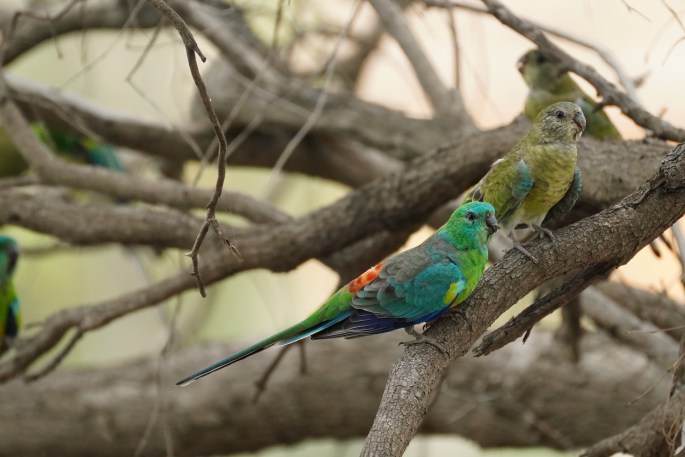



From Wollunga we continued north checking out & rejecting a number of camp spots, finally reaching, after what had been a longer driving day than expected, what proved to be a lovely little $10 a night campground at Cadell , where the river takes a 90 degree turn from northward to eastward – heading upstream, across to Victoria. (It’s a long river 2500kms). The Graeme Claxton Reserve. Right on the river, with river cliffs on the other side of the water which ‘glow’ at sunrise.

Next morning we crossed the Murray on a ferry. One of a number we have used. These vehicular ferries are provided free of charge, as they are considered to be part of the road network, & are presumably a cost effective alternative to building bridges. We like that they have existed for a long time & continue in use. They operate throughout the day & waiting for the ferry to return from the other side of the rivers seems quaint & no hardship.

Once across, & up the surprisingly steep climb away from the water, we headed north for a foray away from the river to a well known (among birders & naturalists) bird refuge. Gluepot Reserve (named we think because of what it’s roads can become with just minimal amounts of rainfall) is the largest intact tract of Mallee country remaining in Australia. It low trees & sparse ground cover provides habitat for a number of endangered species lost to us as a result of huge areas of country where buldozers & chains have been used to ‘clear’ the land for agricultural purposes. We were looking forward to the possibility of adding a few ’new’ birds to our ‘seen’ list. Top ‘prize’ if we were lucky would be sightings of our first ever Grasswren, the Striated Grasswren, commonly described, like all the various types of Grasswren as ‘cryptic’, which is basically a description meaning ‘hard to find/see’.
The drive to Gluepot took us off sealed roads & onto corrugated sandy tracks for the first time in the OKA, which took it in it’s stride. Reducing our tyre pressures & averaging 30kph for several hours got us there unscathed. It was good to be back into non-humanised (except for the track) country.


Being so hot & dry, the main locations to see birds were at the several bird hides with water baths for the birds to drink at. This limited the variety of birds we could see, but nevertheless there were ‘new’ ones for us. Another place to return to (when conditions are conducive to seeing more away from the hides). Neverthless we took a couple of early morning walks on some of the many walking tracks & thorougly enjoyed being immersed in the Mallee…… including seeing some Striated Grasswrens! These diminutive ‘punk rockers’ are very distinctive, but also very fast moving in & around the clumps of spinifex where they live. You hear them first & then , with luck catch the briefest sighting. We got lucky 4 times, but never with enough time to focus the camera & get a shot. BUT I’ve seen one! Yay! Unless you, the reader, have an interest in bird spotting, a few seconds glimpse of a tiny bird probably doesn’t sound like much, but for us it was very exciting & worth the rising at dawn & the 5 kilometre hike through the scrub to an area we had been told that the birds had recently been seen.



We left ‘Gluepot’ a day earlier than planned after we discovered a mechanical problem which required workshop attention. The night prior to the Grasswren sighting, whilst driving back to camp we had turned on the OKA’s cab air conditioning & found it had ceased working. Not getting cold & a tick tick tick noise from somewhere in the vicinity of the motor. At camp the issue became obvious, the air conditioning air compressor was flopping around & it’s drive belt had come off the compressor’s drive pulley. The ’ticking’ noise we had heard was the loose belt coming into contact with the plastic blades of the engine’s cooling fan. Thankfully it must have only ‘just’ been ‘kissing’ them as none were damaged. Phew! Having a non working engine fan in such a location would have been disastrous, but we were spared that & I was able to remove the drive belt so we could drive back to civilisation, albeit without air con. A secondary problem was that a warning light on the dash lit up & an error code suggested it was something to do with high or low voltage associated with the pressurised fuel of the common rail fuel system. My first thought was that with the compressor coming loose ( the head had sheared off it’s pivot bolt & the bolt had worked it’s way out) that an electrical connection had been disturbed, but I could find no evidence of this.
Past experience suggests strongly that getting mechanical help whilst travelling is fraught with risk. Akin to ‘russian roulette’. How do you pick the good ones & not the ‘cowboys’ . We have learned that you can’t go on the size of the company. We once tried that thinking a big company with a reputation to protect would serve us well & found to our dismay that we received a ‘cowboy’ job which cost us dearly down the track. The company which can fit you in a timely manner most probably in need of work for a reason. We’ve had that happen before as well. This time the nearest town with services would be Renmark, a town big enough to have a large Coles supermarket (or was it Woolies – they’re all the same to me) & thus big enough for there to be several mechanical workshops to choose from. This time I googled the various companies (because I could) & one company seemed to stand out in the reviews, particularly with comments like “fitted in at short notice, good job & fair price”. With nothing else to go on that sounded good & worth what would still be a gamble.
Well RedMud Automotive & Electrical proved to be as good as their reviews, they fitted us in that afternoon & finished the job the following morning. We camped the night close to the large workshop’s rear door in a public town centre carpark in front of a Harvey Norman furniture store having been assured it was fine to do so. I just wish we had realised that the lights above us would come on at night making the entire night like day!

I had phoned ahead to book us in & the owner himself started work on our truck almost as soon as we got there. I had thought the broken bolt may have sheared as a result of the vibration from the corrugated roads, but when examined (we still had it – found it sitting on top of the motor) he assured us that it had been fractured for a long time & that we had just ‘finished it off. He could tell by the nature of the break. The cause, he told us was that a bush in which the bolt sits had been put in back to front at some point in history & a flange on the bush intended to act as a ‘spacer’ was unable to do so, meaning there had always been lateral movement where there should have been none. If I had had a bolt of the right size I would have done the job myself before leaving Gluepot, but I didn’t & it would not have solved the causative problem anyway. The bush was removed & reinserted correctly using a vice to press it in. A job I would have been unable to do even if I had recognised the need. Once the passenger seat & engine access panel next to it had been removed the compressor could be partially removed without disconnecting it from it’s gas lines two further things were discovered. The lower adjustment bolt was broken and hidden ‘underneath’ the compressor was a electrical connector which had been pushed apart when the ‘headless’ pivot bolt was working it way out. So I had been correct about the cause of the error code, I just hadn’t been able to see it. The engine had run well enough to get ust to Renmark but we did experience a couple of unexpected gear changes on hills, the fuel pump trying to compensate interacting with the Allison auto transmission. No harm done, but not a good thing if allowed to continue long term apparently.
We drove away from Renmark before lunch time feeling we had been treated very well, & the truck was back to it’s normal running.
We again wanted to go to a riverside camp, but found large puddles from recent rain we hadn’t seen. Riverside tracks have a reputation for being treacherous when wet. Past experiences came to mind of when we got out of a camp by the skin of our teeth. 15 minutes later & we would have been stuck for several days, We slipped & slid in 4wd along a dirt road for a while, eventually reaching the turn off to the last few kms into the camp spot & saw the entire narrow track ahead of us covered with water. One of us thought it would not be a good idea, citing stories we had heard about the difficulty of extracting a 7 tonne from a bogged situation where there were no trees to attach a winch to. Thankfully I recognised the sense in what was being said to me, & avoided a “she’ll be right/oops” situation. The commonsense behind the advice was proven when, in order to turn around I needed to make a 3 point turn, reversing onto the beginning of the water covered track. Thankfully I was smart enough to ensure our front wheels remained on the relatively dry section of track we had come in on. The rear wheels spun, despite very judicious use of the throttle (the 4 cyl motor has a lot of low down torque), but the front wheels pulled us out. No harm done apart from the thick layering of mud on the truck.
So back to the bitumen, back to the highway & onwards in an easterly direction, back to the top lefthand corner of our home state of Victoria, albeit briefly. We gave up on changing the time on our clocks, & remained on ‘our’ time rather than switching time to the state we were in, given that we were actually to cross borders several time in within a day or two. The weather remained overcast & drizzly, much the same as our mood as we needed to drive significantly further than we had expected to. The sight of what we think were multiple swarms of bees, over a stretch of around 10 or 15 kms, peaked our interest & made us smile. The swarms were huge & looked like the murmuration seen sometimes with starlings, not quite on the same scale but interesting nonetheless. We were at a loss to explain why we saw several incidences of this over that stretch of road. A night on a hidden piece of ‘waste ground’ on the rivers edge before crossing into New South Wales the next morning via a bridge over the river. Access to the water with a bucket helped to remove much of the thick red clay still clinging to the truck, aided by sticks. On the other side of the river was Wentworth. This brought back a few memories! It was here in the town where The River Murray & The Darling River meet, many years ago when our young son was bitten by a snake, or so we thought at the time. Memories of an emergency dash across country to get medical help. We think he actually sat on a ‘3 corner jack’, a nasty type of prickle often found on the ground in these parts. He even told us he had seen the snake! Very worrying at the time but now a family story which is always good for a laugh
No ’snakes’ this time around, we only stopped to make use of the laundromat before continuing north to another spot we knew at Pooncarie, a spot where I celebrated my first birthday (age 60) on the road back in 2017 not long after we commenced full time travel ( https://cuppa500.com/Blog/the-real-beginning/ ). We expected to stay here for several days waiting for some friends from Adelaide to arrive in their OKA, with the plan of driving the rest of the way to the biannual OKA gathering with them, this year being held in Silverton, near Broken Hill. After a couple of days they arrived but had received some family news meaning they had to return & could not come to Silverton, but we had a further couple of days enjoying their company made special by the knowledge that they had driven a considerable distance in order to just spend a couple of days with us.


Next stop was Menindee, or more precisely Lake Pamamaroo a short distance outside of Menindee. There had been talk of a few OKA folk gathering at the Burke & Wills campground prior to the Silverton gathering, but we ended up being there alone (if you don’t count the numerous cormorants & pelicans which kept us amused with their fishing antics at the bottom of the weir where water from the lake continues south as the Darling River.




Now we were beginning to get into desert country , flat with extensive views. Outback – no fences. Driving toward Broken Hill. There had been rain. No puddles but the edges of the road were bright green where water had collected. We started to see road kill. Kangaroos & mainly, a single wild pig, an emu or two, occasionally a goat & a couple of smaller animals we couldn’t identify as we passed or straddled them . All had the inevitable murder of crows feasting on them, occasionally hiding a larger wedge-tailed eagle among them. The crows get out of the way without problem, but the eagles are slow to leave, more cumbersome getting into the air & unpredictable as to what direction they will fly in, so caution was required each time we saw crows on the road ahead. Caution also required to avoid adding to the road kill. Feral goats are pretty savvy, unless an adult is on one side of the road, & it’s kid on the other. The kid is highly likely to make a last second dash. Most roos seem sensible enough, apart from the older one snoozing at the side of the road in the shade of a bush. I think we woke him & he reacted without having got his wits about him. Thankfully we had seen him & kept well wide, otherwise he would have gone under our wheels. Emus are completely unpredictable & big! Driving at sensible speeds & constantly scanning the roadsides ahead is tiring but necessary. There are not a lot of places for the animals to hide, but if they are not on the road itself they blend very well into the background.
Broken Hill is what it sounds like. A hill among a range of hills rising surprisingly steeply from the flat country which surrounds them. ‘Broken’ because it is essentially a huge mine (zinc, lead & silver) with an historic town attached (it has been mined continuously for around 130 years). Please excuse my not sharing a lot of tourist style info about the places we have been to in this post. Most are places we have been revisiting, and so have not done much touristy stuff nor taken many photos. I expect that will change when we again begin to discover places for the first time. There is actually quite a lot to discover in Broken Hill if you have never been there. A lot of historical exhibits of differing sorts & perhaps surprisingly an active & long standing art community. We stopped in town to shop for supplies & to collect a parcel at the post office. New window stays to replace the ones that had failed at Boothby Rocks earlier in the trip.
On to Silverton, the ‘Mad Max township’ – again we didn’t go to the museums & art galleries, having been in the past. Instead we stayed at Penrose Park & enjoyed the company of fellow OKA owners, & the opportunity to look at other OKAs. We did weaken and visit the Silverton bakery for pies & coffee though, along with a group of new friends.
It was whilst we were at Silverton that we heard about the rain & the huge number of road closures. We learned that Broken Hill, just 30kms away had had a day & ahalf of rain, with flash flooding in the main street & other country around us had copped some too. At one point the road between Silverton & Broken Hill had been closed by water over the road- only for a day though. Throughout all of this at Silverton all we had were threatening clouds surrounding us & minor drizzle. We began to wonder where we might go from Silverton. The road out through Mundi Mundi & then northward on station tracks no long seemed a wise option. The road north from Broken Hill to Tibooburra was closed and every road north of the NSW /Qld border was closed. This left the only options to return to Menindee & wait, or to head south. Neither option had great appeal. On the morning we were due to leave we phoned the Tibooburra Police station receiving the news that the road up to there had just been opened ‘with caution” apparently there was the possibility that there would be rivers flowing over the road in a couple of places. “There’ll be a bit of silt built up but you’ll be ok if you take care”. We made a decision to head to Tibooburra, taking the view it was at the ‘bottom edge’ of what were being described as unprecedented floods of the Channel Country to our north. Unprecedented not just because of the amount of rain that fell, but because of the widespread nature of the event. At this point, two weeks later details are increasing but predictions of how long before it will be possible to drive the route we have planned remain in the realm of ‘how long is a piece of string’. We only had to cross one river flowing across the road up to Tibooburra, but were unable to visit Milparinka on the way as it’s swollen river was too wide & deep to contemplate. It takes little for rivers to flood in this desert country with such huge run off. Milparinka & Tibooburra had received arounf 50mm of rain. Huge in these parts, but nothing compared to what was happening a few hundred kms north.



For those of you unfamiliar with Australia’s channel country, it is huge area used to flooding. A number of major rivers split & rejoin, spilling out onto extensive flood plains every few years, cutting roads, & cutting off communities, but this time it’s different. The area which has flooded is 2.9 times the size of the UK! Every road in that entire area closed! Stations & towns inundated. Stock losses in the 100,000’s Imagine that. Hard to get my head around & we are here at it’s edge hoping to get the best info, when info is still hard to get, particularly current info. Things are changing so fast that yesterday’s info is now meaningless. Places which receive 100mm of rain in a good year received over 600mm in a single day, but they had days & days & days of more rain after that! One river (of many), & not the largest by far, the Paroo River, one which stops flowing most years leaving long waterholes that we have enjoyed camping by in the past, at it’s peak was flowing 160gigalitres a day. Compare that to the maximum the Murray River saw in the 1956 flood of less than 30Gigalitres per day.


Our decision to stay & wait in Tibooburra was made easier as we knew of a lovely little campground operated by the Tibooburra Aboriginal Land Council, it has what we need for an extended stay – Good drinking water, out of town, flushing loos, hot showers & a great shelter/shade shed with tables. All in a surrounding that we like. It’s boulder country on the edge of the Sturt Stony Desert, with plenty of wildlife.
We have been here now for two weeks & fallen into a way of desert living. Clear sunny days, blue skies & tops of low to mid 30’s are easy to take. Our mindset is ’staying’, as we expect to be here for at least another 2 or 3 weeks. By then we hope to have some sense of whether we will be able to continue north. The waters are slowly working their way South east toward lake Eyre in South Australia, a mostly dry but huge salt lake in the middle of the country, below sea level. The two big unknowns are how long will it take so much water to drain south & how much damage to roads will have been done. We have already seen photos of roads washed out with washouts large enough to hide big double decker cattle trucks, bridges washed away etc. There is a lot of talk of some places remaining cut off for months, not weeks, but our hope is that as the area slowly re-opens bit by bit that there may be a chance of getting through next month. If not we will head down & across to Port Augusta & up the middle of the country on the Stuart Hwy, but for now we think it worth waiting with fingers crossed. This is not a bad place to be, & we are making ourselves useful having negotiated a semi caretaking role whilst we are here, it occupies us without being onerous & helps cover our camping fees. More importantly it gives us a couple of links to the local community.
Here are a variety of photos taken here.



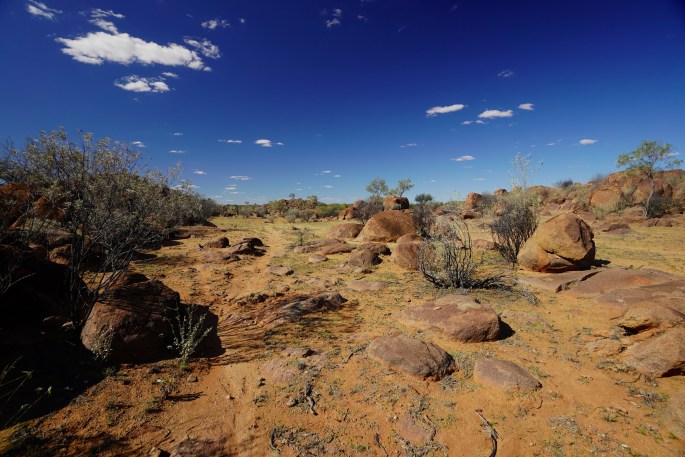




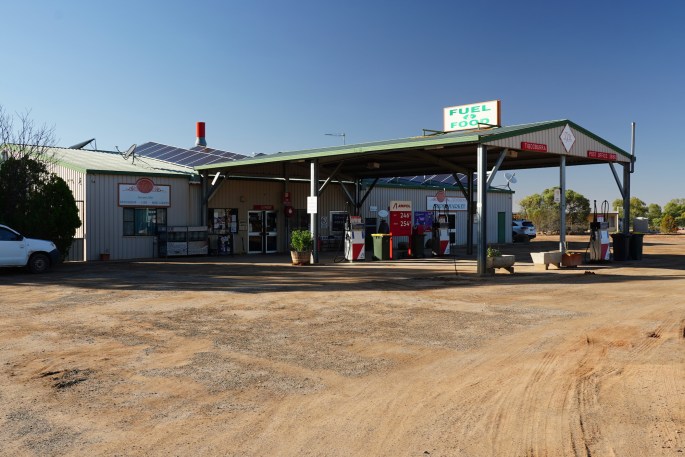




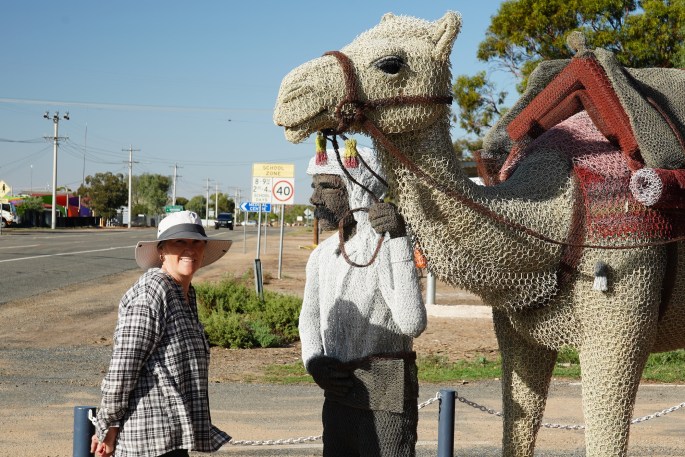
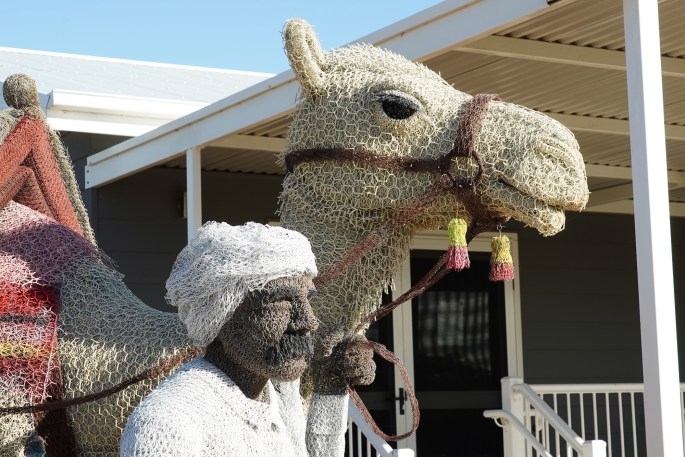














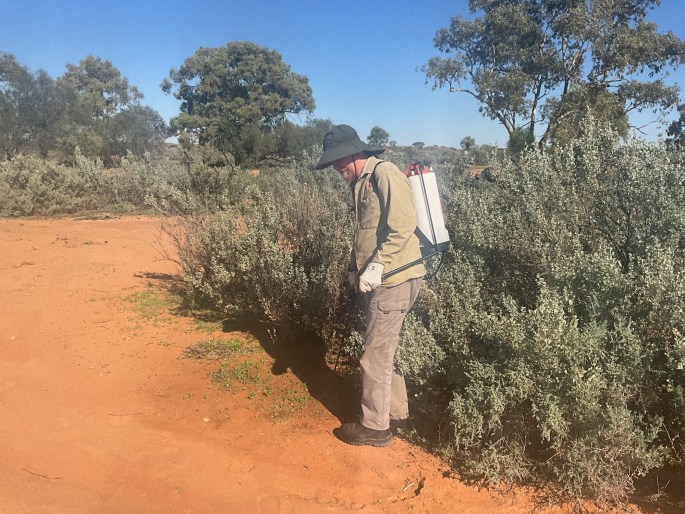








Hopefully the next time we post we will be on the move again.
All the best, love from us both.


Great spot you’ve found there. We were a few weeks ahead moving into the channel country. At that point, moving through Sa, then Vic, then central NSW and finally into Qld we had nearly four weeks of 40 degree weather and decided to make a beeline for Darwin. Just after leaving Mt Isa we heard about the rains coming, so we just missed them on the other side! Hope the way opens up for you soon, but we are hearing of lots of road damage.
Thanks for the update. We love following your travels and experiences.